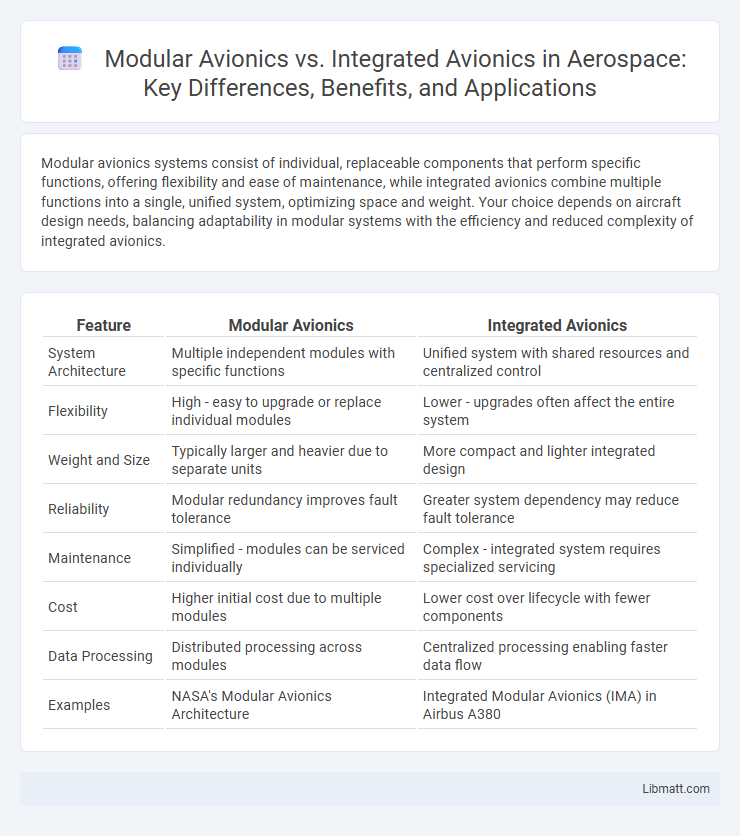Modular avionics systems consist of individual, replaceable components that perform specific functions, offering flexibility and ease of maintenance, while integrated avionics combine multiple functions into a single, unified system, optimizing space and weight. Your choice depends on aircraft design needs, balancing adaptability in modular systems with the efficiency and reduced complexity of integrated avionics.
Table of Comparison
| Feature | Modular Avionics | Integrated Avionics |
|---|---|---|
| System Architecture | Multiple independent modules with specific functions | Unified system with shared resources and centralized control |
| Flexibility | High - easy to upgrade or replace individual modules | Lower - upgrades often affect the entire system |
| Weight and Size | Typically larger and heavier due to separate units | More compact and lighter integrated design |
| Reliability | Modular redundancy improves fault tolerance | Greater system dependency may reduce fault tolerance |
| Maintenance | Simplified - modules can be serviced individually | Complex - integrated system requires specialized servicing |
| Cost | Higher initial cost due to multiple modules | Lower cost over lifecycle with fewer components |
| Data Processing | Distributed processing across modules | Centralized processing enabling faster data flow |
| Examples | NASA's Modular Avionics Architecture | Integrated Modular Avionics (IMA) in Airbus A380 |
Introduction to Avionics Architectures
Modular avionics architecture offers flexibility by allowing individual components or modules to be upgraded or replaced independently, enhancing maintainability and reducing lifecycle costs. Integrated avionics architecture combines multiple functions into a unified system, optimizing performance through shared processing resources and data buses but may increase complexity and dependency risks. Choosing between modular and integrated architectures depends on factors such as system scalability, fault tolerance, and the specific requirements of aircraft missions.
Defining Modular Avionics Systems
Modular avionics systems consist of interchangeable, standardized components designed to simplify maintenance and upgrades by allowing individual modules to be replaced without affecting the entire system. These systems improve reliability, scalability, and flexibility compared to integrated avionics, which combine multiple functions into a single, often proprietary, unit. Your aircraft's operational efficiency and future-proofing benefit significantly from the adaptability and ease of integration that modular avionics provide.
Overview of Integrated Avionics Systems
Integrated Avionics Systems combine multiple avionics functions into a single, cohesive unit, enhancing system efficiency and reliability while reducing weight and wiring complexity. These systems improve real-time data processing and facilitate better communication between avionics components, contributing to optimized flight performance and safety. Your aircraft benefits from streamlined maintenance and upgraded functionality when utilizing integrated avionics over traditional modular systems.
Key Differences Between Modular and Integrated Avionics
Modular avionics feature separate, standardized units that perform specific functions, allowing for easier upgrades and maintenance, whereas integrated avionics systems combine multiple functions into fewer hardware components to optimize space and reduce weight. Modular systems offer flexibility and scalability, benefiting complex aircraft with varied mission requirements, while integrated systems emphasize efficiency and streamlined data processing ideal for modern commercial and military aircraft. The choice between modular and integrated avionics depends on factors like aircraft design, mission complexity, and lifecycle cost management.
Benefits of Modular Avionics
Modular avionics offer significant benefits including enhanced flexibility, easier upgrades, and simplified maintenance compared to integrated avionics systems. By using standardized modules, you can quickly replace or upgrade individual components without overhauling the entire system, reducing downtime and lifecycle costs. This adaptability supports improved system reliability and scalability in complex aircraft avionics architectures.
Advantages of Integrated Avionics
Integrated avionics systems offer significant advantages such as reduced weight and space by consolidating multiple functions into a single platform, leading to enhanced aircraft efficiency. They provide improved data sharing and communication between systems, resulting in faster response times and increased reliability. Maintenance and updates are streamlined, lowering operational costs and minimizing downtime compared to modular avionics configurations.
Challenges of Modular vs Integrated Avionics
Modular avionics face challenges such as increased complexity in system integration, higher weight due to multiple discrete units, and potential issues with signal interoperability across modules. Integrated avionics systems struggle with limited flexibility for upgrades and maintenance, as well as increased risk of total system failure due to their monolithic architecture. Both approaches must address trade-offs between scalability, reliability, and lifecycle cost in aerospace applications.
Impact on Aircraft Design and Maintenance
Modular avionics significantly streamline aircraft design by allowing independent upgrades and scalability, reducing overall development time and costs. Integrated avionics systems, while offering seamless data fusion and improved system performance, can complicate maintenance due to tightly coupled components requiring specialized diagnostics. Maintenance efficiency improves with modular avionics through simplified troubleshooting and part replacement, enhancing aircraft uptime and lifecycle management.
Future Trends: Modularization and Integration
Future trends in avionics emphasize the convergence of modularization and integration, enhancing system flexibility and scalability while maintaining reliability. Modular avionics allow for easier upgrades and maintenance by using standardized, interchangeable components, whereas integrated avionics focus on seamless data sharing and centralized processing to optimize aircraft performance and reduce weight. Emerging technologies such as open architecture systems and distributed processing are driving the evolution toward hybrid solutions that combine the strengths of both modular and integrated approaches for next-generation aerospace platforms.
Choosing the Right Avionics Architecture
Choosing the right avionics architecture depends on mission complexity, system scalability, and maintenance requirements. Modular avionics offer flexibility and easier upgrades by using independent, interchangeable units, making them ideal for evolving systems. Integrated avionics provide optimized weight, power efficiency, and streamlined data processing, suited for highly compact and performance-critical aircraft designs.
modular avionics vs integrated avionics Infographic

 libmatt.com
libmatt.com